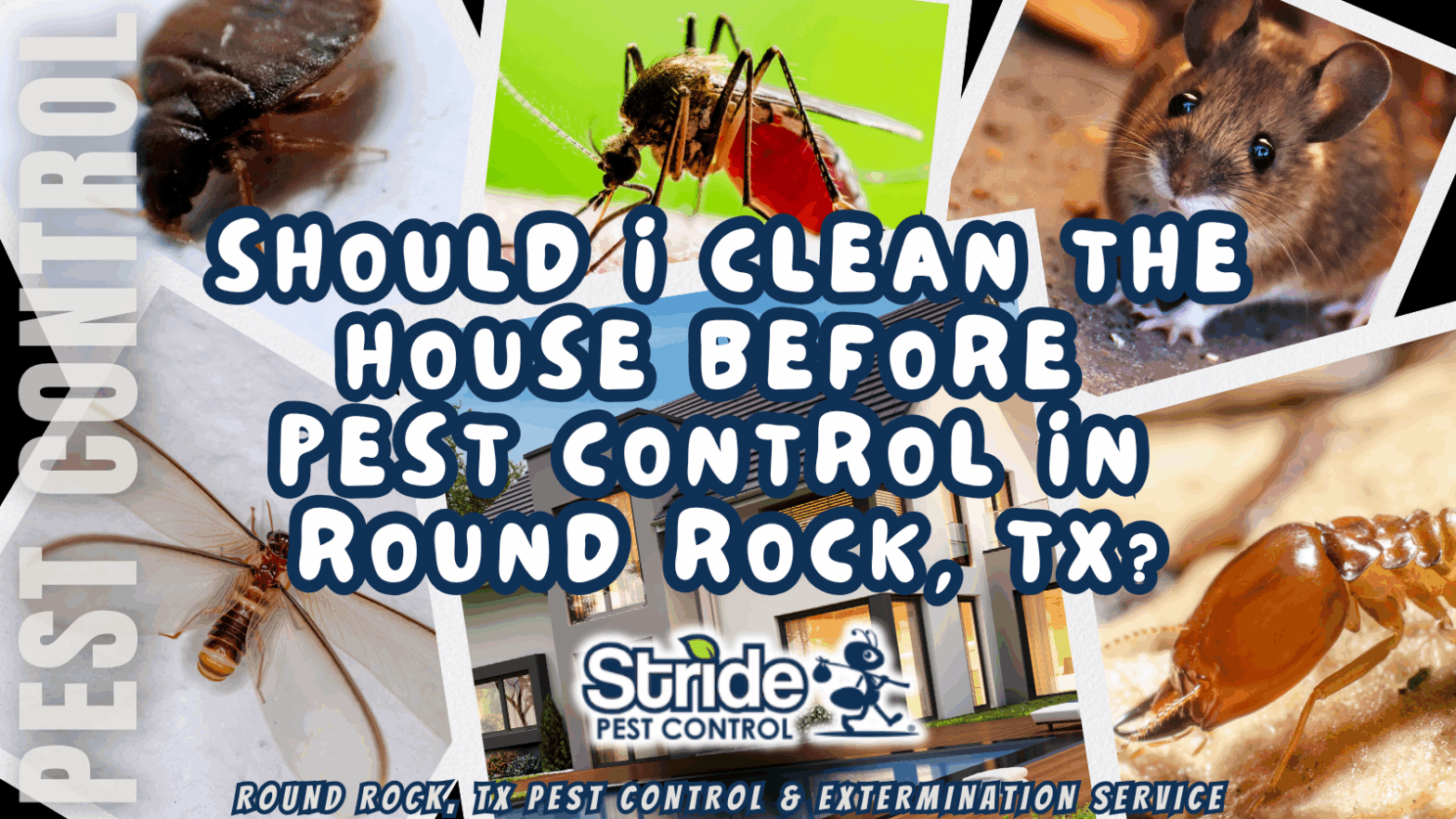
Cleaning the house before pest control in Round Rock, TX, is essential for effective treatment. A clean environment disrupts pest habits and reduces hiding spots. It makes it easier for exterminators to access key areas and apply treatments effectively. Sanitize food areas and declutter rooms to prevent attracting pests. Light cleaning is recommended, while deep cleaning can wait until after treatment. Understanding these steps can greatly improve pest control success, leading to a more pest-resistant home.
Key Article Highlights
- Yes, cleaning before pest control enhances treatment effectiveness by disrupting pest habits and reducing hiding spots.
- Focus on decluttering areas to allow easy access for pest control professionals and effective treatment.
- Light cleaning is recommended; avoid deep cleaning right before service to prevent displacing pests.
- Sanitize food areas to eliminate potential food sources that attract pests during treatment.
- Regular cleaning after pest control helps maintain a pest-resistant environment and prevents re-infestation.
Understanding the Importance of Cleaning Before Pest Control
Cleaning before pest control is vital because it helps create an effective environment for treatment. By understanding pest behavior, individuals can identify where pests thrive and how they access food and shelter. Effective cleaning methods involve removing food debris, sealing entry points, and decluttering spaces. This not only makes the treatment process more efficient but also guarantees that the products used penetrate areas where pests reside. A clean environment disrupts the habits of pests, making it harder for them to survive. Additionally, cleaning reduces the likelihood of re-infestation, as it eliminates the conditions that attracted pests in the first place. Implementing routine inspections as part of your pest control strategy can further enhance the effectiveness of the treatment. Furthermore, addressing entry points during the cleaning process can significantly help in preventing rodent access. Moreover, focusing on moisture zones during your cleaning efforts can help minimize the factors that attract pests to your home. Overall, cleaning before pest control is a significant step in achieving long-term pest management success.
How Clutter Affects Pest Control Effectiveness
Clutter greatly impacts the effectiveness of pest control efforts. In cluttered environments, pests have more places to hide and breed, making it harder for pest control treatments to reach them. Items such as boxes, old furniture, and scattered belongings create ideal hiding spots for insects and rodents. When these pests are not exposed, pest control methods may fail, leading to ongoing infestations. Additionally, clutter can obstruct access to key areas that require treatment, such as corners and baseboards. A clean, organized space allows for better treatment application and monitoring. By reducing clutter, homeowners can enhance the efficiency of pest control efforts, ensuring pests are effectively targeted and eliminated. Addressing clutter is essential for successful pest management. Furthermore, employing residual sprays can be more effective when pests are not hidden away in cluttered spaces.
Areas to Focus on When Cleaning

When preparing for pest control, it is important to focus on specific areas in the home. Clearing cluttered spaces can help eliminate hiding spots for pests. Additionally, sanitizing food areas guarantees that no food sources attract unwanted insects or rodents.
Clear Cluttered Spaces
Before pest control can be effective, it is crucial to focus on clearing cluttered spaces throughout the home. Clutter can create hiding spots for pests, making it difficult for pest control treatments to work. Homeowners should prioritize clutter removal by organizing and decluttering rooms, closets, and storage areas. This process not only makes the space more manageable but also enhances overall space organization. It is helpful to sort items into categories: keep, donate, or discard. By removing unnecessary items and keeping surfaces clear, homeowners allow pest control professionals to access all areas easily. This proactive approach guarantees a more effective treatment, ultimately leading to a pest-free environment. Proper space organization is key to achieving lasting results.
Sanitize Food Areas
Sanitizing food areas is essential in the pest control preparation process. Cleanliness in these spaces is critical for maintaining food safety. First, all food items should be stored securely in sealed containers or removed entirely from the area. This prevents pests from accessing potential food sources. Next, countertops, tables, and other surfaces must be thoroughly cleaned using effective sanitation practices. A mixture of soap and water can help eliminate any residues that might attract pests. Additionally, appliances such as microwaves and toasters should be wiped down. Finally, floors should be swept and mopped to remove crumbs and spills. By ensuring these food areas are sanitized, homeowners can create an environment that is less appealing to pests during treatment.
The Role of Cleaning in Pest Prevention
Cleaning plays an essential role in preventing pests. A clean space reduces the factors that attract pests, such as food crumbs and clutter. Additionally, effective cleaning enhances the success of pest control treatments.
Importance of Clean Spaces
A tidy home acts as the first line of defense against pests. Establishing regular cleaning routines not only enhances the living environment but also disrupts common pest habits. Maintaining cleanliness reduces hiding spots and food sources for pests, making it less likely for them to invade a space.
| Cleaning Routine | Impact on Pest Habits |
|---|---|
| Daily vacuuming | Removes crumbs and debris |
| Weekly dusting | Eliminates nesting areas |
| Monthly deep cleaning | Deters persistent pests |
| Seasonal decluttering | Reduces cluttered spaces |
| Regular trash disposal | Minimizes food sources |
Reducing Pest Attractants
Effective cleaning practices play an essential role in reducing attractants that invite pests into a home. By maintaining a clean environment, homeowners can limit the formation of pest habitats. Regularly removing clutter, especially in hidden areas, decreases the chances for pests to find shelter. Additionally, diligent cleaning of surfaces and floors eliminates food sources that attract pests such as crumbs and spills. It is vital to store food in sealed containers and dispose of garbage promptly to further deter infestations. Ensuring that kitchens and dining areas are free from debris can greatly lower the likelihood of pests. Ultimately, a well-maintained space not only enhances comfort but also serves as an effective barrier against pest invasions.
Enhancing Treatment Effectiveness
While pest control treatments are essential for managing infestations, their effectiveness can be greatly enhanced by a thorough cleaning process beforehand. Cleaning the home removes food debris, clutter, and hiding spots, which are all attractive to pests. Understanding pest behavior is vital, as some pests are more active at specific times. By timing cleaning efforts alongside pest control treatments, homeowners can disrupt the pests’ life cycle and make the environment less inviting. A clean space allows pesticides to reach targeted areas effectively, increasing the chances of success. Ultimately, a proactive cleaning approach not only supports pest control efforts but also helps prevent future infestations, ensuring a healthier living environment for everyone.
Preparing Your Home for Exterminators
Preparing a home for exterminators is essential to guarantee a successful pest control treatment. Proper pest control preparation involves several steps that focus on home cleanliness. First, homeowners should thoroughly clean areas where pests are commonly found, such as kitchens and dining areas. This includes wiping surfaces, cleaning floors, and removing food items. Additionally, using insect growth regulators can help manage pest populations effectively. Next, decluttering spaces makes it easier for exterminators to access problem areas. Additionally, moving furniture away from walls can help the exterminators perform their job effectively. Homeowners should also secure pets in a safe location away from treatment areas. Finally, it’s important to communicate any specific pest issues to the exterminators, ensuring an informed and targeted approach to pest control. Implementing strategies such as mattress encasement can further enhance your efforts in preventing pest infestations.
Common Mistakes to Avoid Before Pest Control

Before scheduling pest control, homeowners often overlook critical steps that can hinder the effectiveness of the treatment. A common mistake is adhering to pest control misconceptions, such as believing that cleaning eliminates all pests. In reality, it can disrupt the treatment if done excessively right before service. Homeowners should follow cleaning frequency tips, which suggest light cleaning instead of deep cleaning before pest control. Additionally, neglecting to inform the pest control technician about previous treatments or pest sightings can lead to ineffective solutions. Finally, failing to prepare specific areas where pests are frequently seen can compromise the process. By avoiding these mistakes, homeowners can guarantee a more successful pest control experience.
Long-Term Benefits of a Clean Home for Pest Management
Maintaining a clean home offers significant long-term benefits for effective pest management. Long-term cleanliness helps reduce food sources and hiding places for pests, making it harder for them to thrive. A tidy environment promotes pest resistance, as fewer crumbs and clutter minimize the chance of infestations. Regular cleaning also allows homeowners to spot potential issues early, such as leaks or cracks that may invite pests. Additionally, a clean home encourages a proactive approach to pest control, limiting the need for harsh chemicals. By fostering a habit of cleanliness, residents can create a less hospitable environment for unwanted insects and rodents. Ultimately, investing in a clean home not only enhances comfort but also strengthens defenses against pests.
Frequently Asked Questions
How Long Should I Wait After Cleaning Before Pest Control Service?
After cleaning, it’s advisable to wait at least 24 hours before scheduling pest control. This timing allows for effective pest control treatment, ensuring that cleaning strategies do not interfere with the application and effectiveness of pesticides.
Can I Vacuum After Pest Control Treatment?
After pest control treatment, vacuuming immediately may seem like a heroic act, but it can reduce pest control effectiveness. Employing smart vacuuming techniques, one should wait at least a few days for best results.
Should I Move Furniture Before Pest Control?
Before pest control, moving furniture can help expose areas where pests hide. Adjusting furniture placement allows pest control professionals to treat affected spots effectively, ensuring a more thorough and successful pest management process.
Do I Need to Wash My Bedding Before Pest Control?
Washing bedding before pest control enhances bedding safety and contributes to pest prevention. Clean sheets help eliminate potential pests and their eggs, ensuring a more effective treatment and a comfortable sleeping environment afterward.
Will Cleaning Products Affect the Pest Control Treatment?
Cleaning products can act like a double-edged sword. Cleaning residues may interfere with chemical interactions during pest control treatments, reducing effectiveness. It’s wise to consult professionals about cleaning practices before treatment for ideal results.
Call today if you are in need of a pest exterminator in Round Rock, TX!
(512) 254-8185

